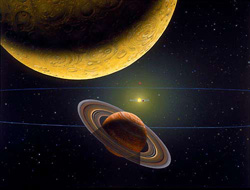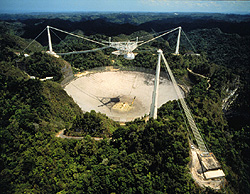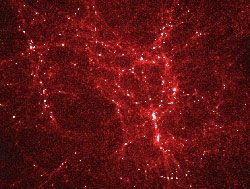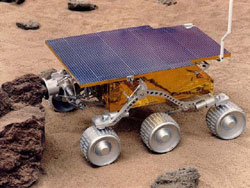Are we alone in the universe? This question has fascinated humans
for centuries.
by Sir Martin Rees, Astronomer Royal
More
than 400 years ago, Giordano Bruno, an Italian monk, wrote that
"In space there are numberless earths circling around other
suns, which may bear upon them creatures similar or even superior
to those upon our human Earth." Bruno deserves to be remembered
in the millennium year -- he was burnt at the stake, in Rome, in
the year 1600.
In
the late 19th century, the science fiction of Jules Verne and H.G.
Wells popularised the idea of alien life. Percival Lowell, a wealthy
American, built his own observatory in Flagstaff, Arizona primarily
to study Mars. He believed that its surface was criss-crossed by
'canals', dug by an advanced civilisation to channel water from
the frozen polar caps to the 'deserts' near the Red Planet's equator.
In 1900,
a French foundation offered the Guzman Prize of 100,000 francs for
the first contact with an extra-terrestrial species; but prudence
led them to exclude Mars -- detecting Martians was then thought
to be too easy!

NASA Is
there life on Mars - the idea has always fascinated us.
|
How life
began, and whether it exists elsewhere remains one of the most fascinating
questions in the whole of science -- indeed, you don't need to be
a scientist to wonder about this. But we still don't know the answer.
We're less optimistic about Mars than our forbears were a hundred
years ago. Even if there is life there, it would be nothing more
than microscopic 'bugs' of the kind that existed on Earth early
in its history--- there is certainly nothing on Mars like the 'Martians'
of popular fictions.
Indeed,
nobody now expects 'advanced life' on any of the planets or moons
in our Solar System. But our Sun is just one star among billions.
And in the vastness of space far beyond our own Solar System we
can rule out nothing. Astronomers have discovered, just within the
last five years, that many stars have their own retinue of planets.
There are millions of other Solar Systems. And there would surely,
among this vast number, be many planets resembling our Earth.

Lynette Cook Life
could be everywhere - over 31 planetary systems have been
discovered around other suns
|
Could
some of these planets, orbiting other stars, harbour life-forms
far more interesting and exotic than anything we might find on Mars?
Could they even be inhabited by beings that we could recognise as
intelligent?
If intelligent
aliens were common, shouldn’t they have visited us already?
Some people, of course, claim that aliens have indeed visited us.
But the evidence for UFOs is no better than that for ghosts, and
I'm personally quite unconvinced. Some astronomers cite this as
evidence that aliens are rare. They note that some stars are billions
of years older than our Sun, and point out that, if life were common,
its emergence should have had a 'head start' on planets around these
ancient stars.
But the
fact that we haven't been visited doesn't, in my view, imply that
aliens don't exist -- the question remains open. It would be far
harder to traverse the mind-boggling distances of interstellar space
than to send a radio signal. That's perhaps how aliens would reveal
themselves first. The nearest stars are so far away that signals
would take many years in transit. For this reason alone it makes
sense to 'listen' rather than transmit --- if a signal were detected,
there would be time to send a measured response, but no scope for
quick repartee! (Aliens equipped with large radio antennae could
in any case pick up the combined output of all our TV transmitters
-- if they could decode them, it's hard to think what they might
conclude about 'intelligent' life on Earth!).

Seth Shostak ET
please phone Earth - SETI listens for radio signals from
alien civilisations at the Arecibo Radio Telescope
|
Attempts
to search for such signals have had a hard time getting public funding
(even at the level of the tax revenues from a single science fiction
movie) because the topic is encumbered by 'flakey' associations
with UFOs, and so forth. But there’s a serious effort in California,
backed by hefty donations from some silicon-valley millionaires.
We have
no idea what intelligent aliens would look like -- it would depend
on the habitat that their 'home planet' offered. They could be balloon-like
creatures floating in dense atmospheres; they could be the size
of insects, on a big planet where gravity pulled strongly. Or they
may be freely-floating is space. They could even, as some science
fiction reminds us, be super-intelligent computers, created by a
race of alien beings that had already died out.
Even
if intelligent aliens existed, they may not be transmitting any
signals; and their brains and senses may be so different from ours
that we couldn't recognise them. There may be a lot more life out
there than we could ever detect -- absence of evidence wouldn't
be evidence of absence. There are heavy odds against such searches
succeeding.
But I'm
enthusiastic about these searches, because of the import of any
manifestly artificial signal. Even if we couldn't make much sense
of it, we'd have learnt that 'intelligence' wasn't unique and had
emerged elsewhere. Our cosmos would seem far more interesting; we
would look at a distant star with renewed interest if we knew it
was another Sun, shining on a world as intricate and complex as
our own.

NASA Galaxies,
stars and planets, a cosmic structure we share with any
aliens
|
If we
ever established contact with aliens, what could we discuss with
them? I've argued in a new book that we're assured one common interest.
We'd belong to the same universe of stars and planets, all made
of similar atoms and governed by universal laws. We'd all trace
our origins back to a single 'genesis event' -- the so-called 'big
bang', which happened about 12 billion years ago.
To firm
up the odds on alien life, we need to understand how life begins
and evolves. An extraordinary precession of species (almost all
now extinct) have swum, crawled and flown during the Earth’s
4.5 billion year history. For a billion years, primitive 'bugs'
exhaled oxygen, transforming the young Earth's poisonous atmosphere
and clearing the way for our eventual emergence. We know from fossils
that a cornucopia of swimming and creeping things evolved during
the Cambrian era 550 million years ago. The next 200 million years
saw the greening of the land, offering a habitat for exotic creatures
---dragonflies as big as seagulls, millipedes a yard long, giant
scorpions and squid-like sea-monsters. Then came the dinosaurs.
Their sudden demise opened the way to mammals -- to the evolution
of apes and us. We are the outcome of time and chance: if evolution
was 're-run', there would be no humans, and we can't predict whether
any other species would achieve our dominant role. So we can't lay
firm odds on whether 'intelligence' would emerge on another Earth-like
planet.

NASA Is
there life under the icy crust of Europa?
|
We know
this happened on Earth, but we'd dearly like to discover a second
example where even the earliest stages of life might exist. Mars
remains the best place to look. Three years ago, American scientists
announced evidence for fossil 'bugs' on a meteorite that had come
from Mars. This claim, hyped up at a press conference attended by
President Clinton himself, was dubious and premature -- NASA has
been backtracking on it ever since. We'll learn more from a series
of space probes that will be sent to Mars in the next decade, to
study its surface, and eventually return samples to Earth. And there
are longer-term plans to search elsewhere -- for instance, a submersible
robot will probe the ice-covered oceans of Jupiter's moons Europa
and Callisto.
All this
depends on the space programme. For most of the present century,
space travel was a futuristic concept, familiar from comics and
corn flakes packets. But in July 1969, Neil Armstrong's 'one small
step' made space travel a reality. Those of us who are now middle-aged
can remember viewing 'live' the murky TV pictures of that event:
it seemed a high point in a decade blighted by the arms race and
the Vietnam war.
Another
lasting image from the 1960s was the first photograph of the entire
round Earth, taken from the Moon. Our habitat of land, oceans and
clouds was revealed as a thin delicate-seeming glaze. Our home planet
-- the 'third rock from the Sun' -- is very special. The beauty
and vulnerability of 'spaceship Earth' contrasts with the stark
and sterile moonscape on which the astronauts left their footprints.

NASA Neil
Armstrong's giant leap for mankind was fuelled by the Cold
War.
|
In the
1960s, the first brief excursions to the Moon seemed just a beginning.
We imagined follow-up projects: a permanent 'lunar base', rather
like the one at the South Pole; or even huge 'space hotels' orbiting
the Earth. Manned expeditions to Mars seemed a natural next step.
But none of these has happened. The year 2001 will not resemble
Arthur C. Clarke's depiction, any more than 1984 (fortunately) resembled
Orwell's.
The programme,
announced by President Kennedy in 1961, 'to land a man on the Moon
before the end of the decade, and return him safely to earth', was
lavishly funded because America wanted to beat Russia. Their pride
had been badly dented in 1957, when Russia launched the first 'Sputnik',
and this was a chance to recapture the lead in the space race. Reaching
the Moon was an end in itself: the last lunar landing was in 1972.
Manned
spaceflight now seems a rather jaded spectator-sport: the veteran
senator John Glenn's recent trip in the Space Shuttle may have been
a morale-booster for elderly Americans, but it didn't recapture
the excitement of his pioneering flight 36 years earlier. We admired
the Russian cosmonauts more for their fortitude and DIY skills than
for anything else, as they coped with one malfunction after another
in the decrepit Mir spacecraft.
Nationals
of other countries have hitched rides into space. The British astronaut
Michael Foal heroically survived the hazards of Mir, the Russian
Space Station. French, Bulgarian and Mongolian astronauts have also
made the trip. But none of this has recaptured public enthusiasm.

NASA Perhaps
the best astronauts are robots
|
The practical
case for manned spaceflight was never strong, and it gets weaker
as robots and computers get more powerful. Space technology -- now
funded commercially as well as by governments -- has abundantly
proved its value. Thousands of small unmanned objects have been
launched into orbit.
Satellites
are routinely used for long distance telephones and satellite
tv broadcasts. The 'global positioning satellites' allow planes
or ships to navigate precisely -- and allow solo hikers or sailor
to locate themselves accurately anywhere on Earth, with a pocket-sized
instrument. Weather forecasts depend on pictures and data from space.
Space
exploration need not involve humans. It can be better (and far more
cheaply) carried out by fleets of unmanned probes, exploiting the
advances that have given us mobile phones and high-powered personal
computers.
Cameras
and scientific instruments have beamed back pictures from the other
planets of our Solar system. And the Hubble Space Telescope has
imaged stars and galaxies so deep in space that their light set
out on its journey towards us billions of years before our Earth
and Sun were born. The cosmos is fantastically larger and more complex
than could have been imagined by the ancients who first mapped the
constellations.
The cosmos
confronted with huge spans of time, as well as stupendous expanses
of space. Life on Earth has evolved for billions of years, but our
Sun has burnt up less than half its fuel, and will keep shining
for another five billion years. If life isn't prematurely snuffed
out, our remote progeny will surely -- in the aeons that lie ahead
-- spread far beyond this planet.
We plainly
can't forecast the vastly remote future. But what might happen in
the first decades of the new millennium? How long will it be before
people return to the Moon, and perhaps explore still further afield?

NASA Worth
its weight in gold - a section of the International Space
Station
|
The centerpiece
of the current US programme is the new International Space Station:
this will be in orbit a few hundred miles up, and the size of a
football field. It will be the most expensive artifact ever constructed,
costing its own weight in gold. Even if it is finished -- something
that seems uncertain, given the immense and ever-rising costs, and
prolonged delays -- it will be neither practical nor inspiring.
Thirty years after men walked on the Moon, a new generation of astronauts
will be going round and round the Earth, in more comfort than Mir
can offer, but much more expensively. The astronauts will be able
to do experiments, but most of those could be done more cheaply
by robots in smaller free-flying satellites.
The Space
Station would make somewhat more sense as a staging post on the
way to other planets. But no such follow-up will materialise unless
public enthusiasm revives, or unless some technical breakthrough
renders space travel much cheaper and easier than it now seems.
Present
launching techniques are as extravagant as air travel would be if
the plane had to be rebuilt after every flight. Spaceflight will
only be affordable when it adopts the same techniques as supersonic
aircraft. Tourist trips into orbit may then become routine. And
wealthy adventurers may boldly go further. Future Richard Bransons,
for whom round-the-world ballooning seems too tame and routine,
could aim for the Moon. If Bill Gates seeks a challenge that won't
make his later life seem an anticlimax, he could sponsor the first
expedition to Mars.

NASA Armageddon?
- an asteroid impact on Earth
|
Some
people use the so-called 'insurance policy argument' to advocate
a manned space programme. There is an ever-present risk (though
fortunately a small one) that a comet or asteroid will hit the Earth.
The craters on the Moon's surface are records of these impacts.
An impact on Earth - leaving a huge undersea crater near Chicxulub
in the Gulf of Mexico, probably sealed the fate of the dinosaurs
65 million years ago.
There
is about one chance in 10000 that, within the next 50 years, the
Earth will be hit by an asteroid large enough to cause world-wide
devastation -- ocean waves hundreds of feet high, tremendous earthquakes,
and changes in global weather. This chance is low - but no lower
than the risk (for the average person) of being killed in an air
crash. Indeed, it's higher than any other natural hazards that most
Europeans or North Americans are exposed to.
The ever-present
risk from nature has been augmented since humankind entered the
nuclear and biotechnological age. Humanity will remain vulnerable
to these (probably increasing) hazards so long as it is confined
here on Earth. But once self-sustaining communities exist away from
the Earth -- on the Moon, on Mars, or freely floating in space --
our species would be invulnerable to any global disaster, and whatever
potential it has for the 5-billion-year future could not be snuffed
out.
Whether
on not humans spread beyond the Earth during the next millennium,
we'll still want to know whether we are alone. It would in some
ways be disappointing if searches for alien intelligence were doomed
to fail. On the other hand, it would boost our 'cosmic' self-esteem.
If our tiny Earth were a unique abode of intelligence, we could
view it in a less humble cosmic perspective than it would merit
if the Galaxy already teemed with complex life. We'd have even stronger
motives to cherish this 'pale blue dot' in the cosmos, and not foreclose
life's future -- a future that could be even longer than the time
span over which simple life has evolved into humans. That is why
we should expand our cosmic vision in the new millennium.
|
